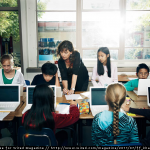 A recent paper released by the University of Leicester explored the role social media plays in our classrooms. The headline from the report was that very few teachers were what they called ‘social media enthusiasts’.
A recent paper released by the University of Leicester explored the role social media plays in our classrooms. The headline from the report was that very few teachers were what they called ‘social media enthusiasts’.
It went on to report that many teachers were found to avoid social media entirely, with around 30% making a conscious decision to stay off of Facebook, Twitter and their like. No doubt a big reason behind their decision was to avoid compromising situations with pupils.
The study prompted teachers and students to come together at the Social Media In Lifelong Education event to discuss the role of social media in education.
“As well as teachers, pupils of all ages have views and experiences of social media use and yet there is often little opportunity for teachers to hear about and discuss their hopes and fears about the use of social media for educational purposes.
“We felt that, whilst many people worry about social media, there were few spaces for these concerns to be raised and to debate the potential of these tools to enhance learning. The University of Leicester will now compile the collective views of participants to create a charter for a way forward for schools,” the organizers say.
The perception is very much one that social media is both hugely risky, and also limited to the main social networks. That’s something I think is a massive shame, and a massive missed opportunity.
Even overlooking the tremendous success achieved by projects such as Khan Academy, or the numerous social attempts to bring computer coding to a younger audience, I have covered a number of fantastically collaborative projects in education.
Projects such as the Flat Classroom Project point the way to the future. One of the main goals of the project is to remove the walls of the classroom and use social media tools to connect classes up with one another and work on projects collaboratively.
Quadblogging is another similar project. It borrows from the penpal relationships of old but brings it very much into the 21st century. The project uses blogs to team four schools together on each project. Each school is required to become active participants in the other schools blogs, and through this gain deeper insight into their own projects.
Collaborative teaching
There are, of course, also a number of projects that are looking to make teaching itself a more collaborative endeavor.
A study by UNC Charlotte highlighted the benefits when teachers collaborate with their peers.
The paper reveals that whilst many schools have tapped into social media to help foster better links with their local communities, very few have utilized it for enabling collaboration between teachers, be it for planning lessons or discussing the needs of students.
“A troubling finding from our study is that the majority of students are not studying in schools where teachers work together and where teachers feel that they are part of professional learning communities,” said study author Stephanie Moller, a faculty member in the Department of Sociology. “African American students are less likely than white and Hispanic students to study in these schools, despite the fact that they benefit the most from studying in such schools.”
The study found that when teachers exist in a collaborative environment, maths scores increase, and also the range of grades between students is reduced.
“The path toward developing these environments in our schools is not without obstacles,” Moller said. “School leaders require a supportive district that provides resources for professional development while also allowing teachers time to work collaboratively. Leadership must also work to obtain teacher buy-in, as a forced community is rarely productive.”
A more recent paper built upon this and explored the world of open educational resources (OER), which are lesson plans and the like, that are made open and freely accessible for other teachers to use, build upon and provide feedback for.
The paper highlighted how a single such platform had already generated over 75,000 resources, which had been viewed around 2.5 million times.
It highlights the potential for more collaborative approaches to teaching. With a number of studies suggesting that there is a big skills gap in collaborative ways of working when children leave education for the world of work, there is much more that needs to be done by schools to adequately prepare children for the new ways of working.
It’s sad therefore that a study into these social ways of working appears to have limited itself to social networking, and the risks involved in using these platforms. If the ‘experts’ in this field are so blinkered, it suggests we have quite a long way to go before children are given the appropriate instructions in the ways of collaborative working.
There have been a few articles on here about researchers not getting social media though, so this isn't a surprise, is it?